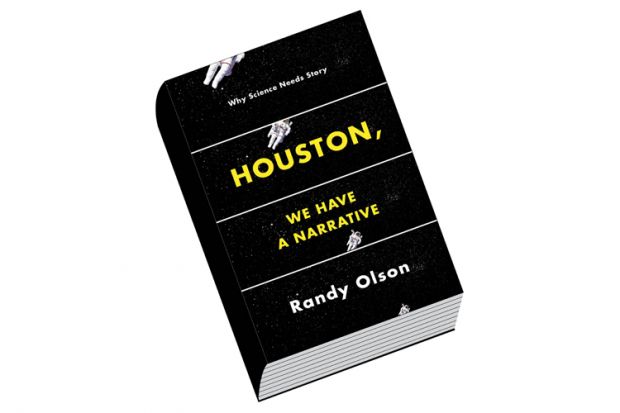Ah, Randy. I can call you Randy, can’t I? After all, you seem to like calling me “dude”, so I figure we must be friends. So tell me: where is this world of which you speak, of ivory towers and tweedy elbow-patched humanities scholars and scientists who detest the concept of shaping a narrative? Of a secure, tenured world of misbehaving work-shy academics, sunshine and roses, a life of ease and plenty that has only weak selective pressures? Because I’d really like to live there.
In Houston, We Have a Narrative, Randy Olson argues that we scientists need to stop spouting dry facts and boring the world to tears simply because we can, and adopt the skills of Hollywood – the ability to tell a good story. The world revolves around good stories, Olson argues, but scientists are not trained in this art. Indeed, he adds, we detest the concept of storytelling and see it as being beneath us, or possibly distortive of science. He also suggests that because we live in the tenured halls of Valhalla – sorry, the academy – there is no driver for the development of good storytelling skills, and that this does science a disservice. The problem is that none of this true.
The academy is extraordinarily competitive. Perhaps not as competitive as Hollywood, and the sums involved are smaller, but nonetheless you are only as good as your latest paper or your last successful grant application. Successful funding applications depend as much on the ability to tell a good story in a clear and compelling way as they do on the science. Getting a paper through an editor and then peer review depends on the rigour of the science, yes, but also on a compelling narrative. I can’t think of a single one of my colleagues and collaborators who doesn’t recognise the importance of a good story. We teach the critical importance of narrative to our third-year undergraduate physicists.
Thus although I simply don’t recognise the reasons that Olson gives for writing this book, that doesn’t mean that he doesn’t have something interesting to say. He presents a simple narrative template for scientists that he calls the ABT, for And, But and Therefore. As in: we work on system X, AND it shows some fascinating properties, BUT there’s this thing that no one understands and that is of critical importance, THEREFORE we did this bit of science. This in itself is fine, and avoids an uninspiring listing of related facts (and…and…and) or confusing the reader with multiple twisting plot lines.
However.
This system, as it stands, is missing the grand finale, the reveal, the climax, the consummation, the denouement. In short, the punchline. Abstracts and scientific papers always have a punchline (“Here we show…”); and even grant proposals, where the punchline can’t actually be known with any certainty, typically culminate in an overarching hypothesis that will be proved or disproved. Olson’s ABT goes only so far, and I would argue that it doesn’t quite go far enough.
Which prompts the question of this book’s intended readership. Is it meant for established scientists? I would hope that they would all know the power of narrative already. If it is addressing scientists just starting out, a word of caution is probably needed. Olson is sensitive to being accused of advising us to “bend the science to tell better stories”, and I agree that there is a delicate balance to be struck. We need to strip out all extraneous non-essential information so as to avoid fact fatigue, but at the same time must not skew the data we choose to present simply to tell a good story.
Unfortunately, Olson tarnishes his own self-defence by holding up The Double Helix, James Watson’s autobiographical account of that landmark discovery, as an excellent example of narrative and storytelling – while freely conceding that Watson’s book was found to have been somewhat flexible with the truth. Alas, Olson can’t have it both ways. So for academics just starting out, and at the risk of sounding a little preachy, I would suggest that you give Mark Twain’s famous adage a 180-degree tweak: always tell a good story by way of the truth.
Cait MacPhee is professor of biological physics, University of Edinburgh.
Houston, We Have a Narrative: Why Science Needs Story
By Randy Olson
University of Chicago Press, 256pp, £42.00 and £14.00
ISBN 9780226270708, 70845 and 70982
Published 29 September 2015
POSTSCRIPT:
Print headline: Spin yarns, but never facts
Register to continue
Why register?
- Registration is free and only takes a moment
- Once registered, you can read 3 articles a month
- Sign up for our newsletter
Subscribe
Or subscribe for unlimited access to:
- Unlimited access to news, views, insights & reviews
- Digital editions
- Digital access to THE’s university and college rankings analysis
Already registered or a current subscriber? Login




